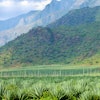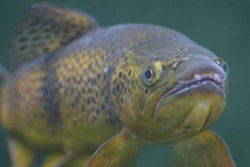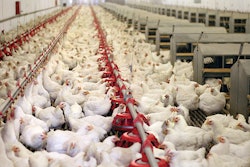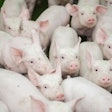
Peas offer a unique advantage, as they are an intermediate between cereals and most protein sources.
Broilers and layers consume close to 60% of global soybean meal production. When we account for pigs, total consumption climbs to 85%. So, it is safe to declare that the majority of soybean meal is consumed by monogastric species.
When soybean meal becomes too expensive or unavailable to use, feed professionals look for alternatives to replace this major protein source. Peas are a significant feed crop in Canada, whereas in the European Union their use is encouraged to aid the initiative of becoming less dependent on imported soybean meal. The future of peas as a feed protein appears promising and their use is expanding, especially because peas can be fed even raw, under certain circumstances.
Peas as a crop
Peas are the seeds of the annual plant Pisum sativus. There are many commercial varieties distinguished by the color of the flower petals (white or yellow), the color of the seeds (yellow, green or brown), the appearance of the seed (smooth or wrinkled), and the season of planting (winter or spring). They are widely cultivated in areas that are rather cold, and thus less suitable for soybeans, such as in northern U.S., Canada and northern Europe. Naturally, they produce less nutrients per acre than soybeans, but there are few alternatives in the environmental conditions where peas thrive.
Nutritive value
Pea seeds contain about the same amount of energy as barley (2,900 kcal AMEn for broilers). This relatively high energy value is a reflection of the presence of about 50% starch in peas. Their protein level is intermediate between that of most cereals and traditional protein sources, ranging considerably from 20% to 26% (as a result of growing conditions and variety selection).
Just as with soybeans, peas are also limiting in methionine, which can be increased if crops are fortified with sulfur fertilizers. On the other hand, in contrast to soybeans, lysine concentration in peas appears to be fixed and is not affected by protein concentration. Peas contain a significant amount of non-protein nitrogen that is usually not taken into account, so total protein concentration can often be misleading as to the protein value of peas. Protein digestibility varies considerably, with brown varieties being the least digestible. Fiber levels are moderate, ranging from less than 5% to up to 10%, again depending on variety (pea seed fiber can be a benefit in the post-antibiotic era as a means of controlling gut health). Finally, peas are a good source of potassium and selenium.
Anti-nutritional factors
Raw peas contain more or less the same type of anti-nutritional factors as soybeans, but at a much reduced concentration. Trypsin inhibitor activity is the main anti-nutritional factor, but its levels appear rather low in spring, white-flowered and yellow- or green-seeded varieties.
Another important anti-nutritional factor is tannins, which also vary considerable according to variety selection. In general, winter varieties and those of more color (in flower and seed) appear to contain more anti-nutritional factors, but this is an oversimplification. As a rule of thumb, feeding raw peas will most likely lead to reduced efficiency of energy and protein, especially when certain “heavy” varieties are fed at relatively high levels. In most cases, raw peas from improved varieties can be fed without major repercussions.
Processing to improve nutritive value
The greatest improvement in energy utilization comes from fine grinding, as opposed to feeding whole or cracked peas. This is certainly the effect of digestive enzymes gaining greater access to starch within exposed cells. Heat treatment (such as extrusion, and even pelleting) appears to mostly improve protein digestibility as anti-nutritional factors are neutralized. Pea proteins are quite sensitive to overheating, which leads to significant protein denaturation and reduced digestibility. Thus, feeding ground raw varieties with reduced levels of anti-nutritional factors is preferred when proper heat treatment methods cannot be applied.
Inclusion rates in broiler feeds
Peas of the best varieties can be used up to 40% in broiler diets without heat treatment. Results can be disappointing if peas are not characterized correctly, so a maximum level of 20% is more reasonable as a generic rule of thumb. Properly heat-processed peas can be fed also rather liberally but, again, if they have been overheated, then performance may suffer. There are some more recent reports indicating that adding certain enzymes may improve performance results, but data are rather inconclusive. Perhaps, the greatest impediment with pea seeds remains the great variability between available varieties.
Inclusion rates in layer feeds
Similar inclusion rates as with broilers can be applied in layer feeds, following the same precautions. Special attention should be paid to methionine concentration because peas are limiting in this amino acid and also due to the fact that amino acid digestibility in peas is lower than that in soybean meal. Lack of proper characterization may lead to methionine deficiency that, even at marginal levels, can significantly reduce egg size.
Inclusion rates in pig feeds
Young pigs less than 25 kg body weight should be fed up to 10% ground raw peas, or up to 20% if peas are properly cooked. Only varieties with the lowest concentration of anti-nutritional factors should be used in piglet feeds. In contrast, feeds for older pigs, including sows, may contain ground raw peas as the only source of supplemental protein; in other words, it can totally replace soybean meal. Again, it is important to properly characterize peas before using them at such liberal amounts. If in doubt, it is best to limit peas to providing 50% of the supplemental protein otherwise being provided by soybean meal.
In brief
Peas are an important protein crop that will become even more significant as other protein sources become less desirable or available at reasonable prices. In feeding peas, it is important to know the variety as there is considerable variation in nutritive value and chemical composition. Cooked peas offer advantages, but such treatment is not always necessary. Under the right conditions, raw peas can be the only supplemental protein replacing soybean meal.

















